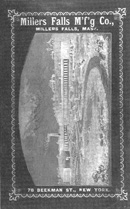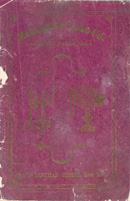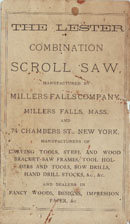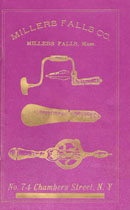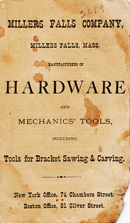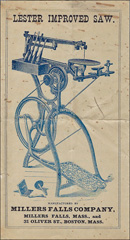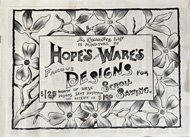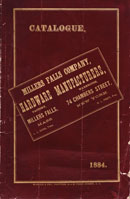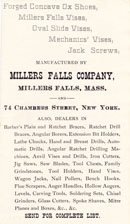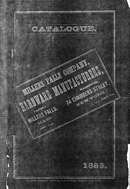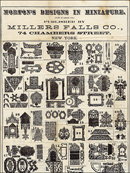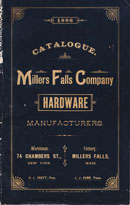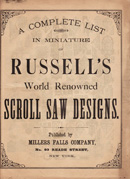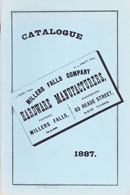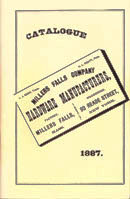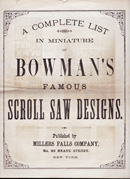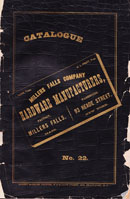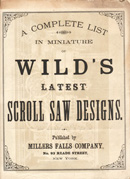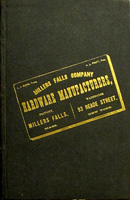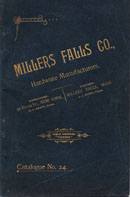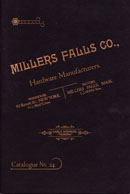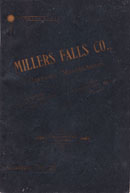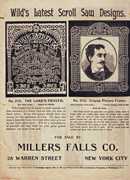Millers Falls Publications — 1872-1899
1872
- Millers Falls Manufacturing Company.
- Millers Falls M'f'g Co., Millers Falls, Mass./Backus Vise Co., Millers Falls, Mass.
- 24 pages : illustrated ; 10 x 14 cm.
- New York : Millers Falls Mfg. Company, 1872.
Title from cover. Item not seen. A combined catalog of the Millers Falls Mfg. Company and the Backus Vise Company. When read from one end, it features Millers Falls tools, from the other, those of Backus vise. The image at left is a black & white copy of the cover on the Millers Falls side of the catalog. A description and several images from the catalog can be located in Elton W. Hall's article “The Development of the Illustrated Tool Catalog.” Chronicle of the Early American Industries Association. v. 61, no. 1 (March 2008), p. 1-15.
1874
- Millers Falls Company.
- Millers Falls Co., Millers Falls, Mass.
- 24 pages : illustrated ; 11 x 18 cm.
- New York : Millers Falls Company, about 1874].
Title from cover. Printed by Tower, Gildersleeve & Co., New York. Date is an estimate. (The Millers Falls New York office address is 78 Beekman St. and fret saws—added to the line during 1874—have yet to appear in the catalog. Includes braces, vises, a breast drill, Stevens' patent hand vise, Wood's patent hollow adjustable auger, the Langdon miter box and Stratton Brothers levels. Scan of extremely worn, low-contrast cover courtesy of Edward Clarke.
1877
- Millers Falls Company.
- The Lester Combination Scroll Saw Manufactured by the Millers Falls Company.
- Millers Falls, Mass. ; New York : Millers Falls Company, [about 1877].
- 1 folded sheet : illustrated ; 14.5 x 34 cm. (unfolded)
Folded accordion style to create a pamphlet and shipped with the very earliest of the Lester saws. One side includes instructions for setup and for using the scroll saw and the lathe. The other side includes illustrations of the device as set up for scroll sawing and for circular saw and lathe work. One panel includes the specifications for the saw with regard to measurements and weight. The deluxe version of the saw sold for ten dollars and weighed thirty-two pounds—considerably less than the fifty pounds of its later incarnation.
1878
- Millers Falls Company.
- Millers Falls Co., Millers Falls, Mass.
- [S. l.] : Philip J. Whitby, 1992.
- 48 pages : illustrated ; 11 x 18 cm.
- Originally published: New York : Millers Falls Company, 1878.
Reprint. Title from cover. Catalog includes braces, vises, hand and breast drills, Stevens' patent hand vise, Wood's patent hollow adjustable auger, Langdon miter boxes, Alexander adjustable jointer gauge, Stratton's levels, Johnson's automatic push drill, the Lester scroll saw, and more.
- Millers Falls Company.
- Millers Falls Company, Millers Falls, Mass.: Manufacturers of Hardware and Mechanics' Tools, Including Tools for Bracket Sawing and Carving.
- New York, N. Y. ; Boston, Mass. : Millers Falls Company, [about 1878].
- 1 folded sheet : illustrated ; 48 x 56 cm. (unfolded)
Unfolds to form a four-page booklet of 24 x 28 cm. Features the Lester Saw and the short-lived Rogers Saw and includes a handful of the smaller tools sold by the company. The cover lists the address for the short-lived Boston office, this pamphlet was distributed between the printing of the 1878 catalog and the introduction of New Rogers Saw in 1879. The back page advertises the availability of a wide variety of scroll saw patterns available from the company—including patterns by the Morton Company and I. B. Farrington.
- Millers Falls Company.
- Manual of Fret Sawing: with Illustrations.
- Millers Falls, Mass. : Published by Millers Falls Co., [about 1878].
- 12 pages : illustrated ; 12 x 19 cm.
Title from cover. Date from testimonial letters published on last page. A small pamphlet with basic instructions for sawing intricate patterns with a hand-held bracket saw. Contains an advertisement for the foot-powered Lester scroll saw. This pamphlet was included in inexpensive kits equipped with a saw, blades, an awl, and paper patterns. Deluxe kits included additional tools and were packed in wooden boxes rather than pasteboard. Published by the Millers Falls Co., the pamphlet's copyright was held by Perry Mason & Company of Boston, the publishers of the popular magazine the Youth's Companion.
1879
- Millers Falls Company.
- Lester Improved Saw.
- Millers Falls, Mass. ; Boston, Mass. : Millers Falls Company, [about 1879].
- 1 folded sheet : illustrated ; 16 x 25 cm. (unfolded)
Folded accordion style to create a document with two covers—one side contains an illustration and information for the Lester Improved Saw; the other side does the same for the New Rogers Saw. Published between the time of the introduction of New Rogers Saw in 1879 and the demise of the Boston office in about 1880. Royal C. Graves, the manager of the Boston office, wrote to the office at the Millers Falls plant about having some scroll saw circulars printed during the summer of 1879. This publication may have been one of them.
1880
- Millers Falls Company
- A Complete List in Miniature of Hope's and Ware's Famous Designs for Scroll Sawing.
- New York : Millers Falls Company, 1880.
- 15 pages : illustrated ; 23 cm.
Title from cover. A tabloid containing illustrations of scroll saw patterns that could be ordered from the company. Includes a number of filigree designs. Back of cover notes: "For sale by Miller's Falls Co., dealer's in scroll saws, scroll saw material, tools, lathes, etc. etc." Intended for a hobbyist audience, many of the patterns are intricate beyond belief. Published on newsprint.
1881
- Millers Falls Company
- Catalogue 1881.
- New York : Millers Falls Company, 1881.
- 48 pages : illustrated ; 23 cm.
Title from cover. The example seen here has had some water damage. The cover was virtually identical to the 1884 catalog save that it was a very dark brown rather than the red-brown of the 1884 publication. This is the catalog that introduced Wallace Lyon's patented brace drill to the public. It is also the catalog carrying an announcement that the firm would no longer be supplying customers with the original Barber Brace since it considered the Barber Improved Brace to be a superior tool. The move proved premature, for within a short time, the firm was once again offering Barber Braces.
1884
- Millers Falls Company
- Catalogue 1884.
- New York : Millers Falls Company, 1884.
- 56 pages : illustrated ; 23 cm.
Title from cover. Printed by McBride & Fry, New York. The only catalog located to date that illustrates the company's "walking beam" scroll saw, a treadle tool featuring "a solid iron frame, rather than wooden arms, as the saw runs in guides." The illustration block used to produce the illustration of the Rogers miter planer on page 53 must have presented a puzzle for the printer. The tool is depicted upside down. Includes such unexpected items as Goddard's patented meat and vegetable chopper and Kohn's trace holder, a pin designed to be driven into a whiffletree.
- Millers Falls Company
- Forged Concave Ox Shoes, Millers Falls Vises, Oval Slide Vises, Mechanics' Vises, Jack Screws Manufactured by the Millers Falls Company, Millers Falls, Mass.
- [No location given] : Millers Falls Company, [about 1884].
- 1 folded sheet : illustrated ; 17 x 32 cm. (unfolded)
Folds in four parts to form a small booklet. After the Greenfield Tool Company folded, the Millers Falls Company acquired the rights the Colburn and Parker patents for the dies used in forging ox shoes and it marketed its output as the Greenfield Forged Ox Shoe. The Parker patent had originally been awarded to Bowdoin S. Parker, the nephew of the company's treasurer, Levi J. Gunn. This brochure was apparently directed to the blacksmith trade. In addition to the ox-shoes, it features heavy-duty metallic vises and the sort of jack screws handy for making wagon repairs.
1885
- Millers Falls Company.
- Catalogue 1885.
- New York : Millers Falls Company, 1885.
- 56 pages : illustrated ; 23 cm.
Title from cover. Printed by R. McBride, New York. Issued during a period when the company derived a significant part of its income from the sale of tools for the home hobbyist. In addition to the tools seen in the catalog, the customer could send away for lists of over 850 patterns for scroll saw projects. A photocopy of cover is shown here. The original cover is a low-contrast combination of gold on green. Issue examined has an 1885 trade discount sheet inserted.
- Millers Falls Company.
- Morton's Designs in Miniature: Published by Millers Fall Co., 74 Chambers Street, New York.
- New York : Millers Falls Company, [about 1885].
- 1 sheet : illustrated ; 23.5 x 59.5 cm.
Title from top of sheet. A broadside printed on front and back. The front of the sheet includes small illustrations of scroll saw patterns that could be ordered from the company; the back lists prices for the individual patterns. Includes designs for corner shelves, clock cases, picture frames, towel racks, etc.
Over twice as long as it is wide, the top part of the front side is reproduced here.
1886
- Millers Falls Company.
- 1886 Catalogue: Millers Falls Company, Hardware Manufacturers.
- New York : Millers Falls Company, 1886.
- 32 pages : illustrated ; 23 cm.
Title from cover. Printed by D. H. Gildersleeve, New York. This edition of the catalog was produced with a reduced page count. Notable omissions include several versions of the Langdon Miter box; a number of the handheld saws, several vises, and the Rogers miter planer. All of these tools were in production at the time of publication.
- Millers Falls Company.
- A Complete List in Miniature of Russell's World Renowned Scroll Saw Designs.
- New York : Millers Falls Company, [about 1886].
- 16 pages [including front & back covers] : illustrated ; 24 X 30 cm.
Title from cover. A tabloid containing illustrations of scroll saw patterns that could be ordered from the company. Includes designs for corner shelves, clock cases, picture frames, towel racks. etc. Published on newsprint.
1887
- Millers Falls Company.
- Catalogue 1887.
- Fitzwilliam, New Hampshire : Ken Roberts Pub. Co., 1981.
- 62 [i.e., 72] pages : illustrated ; 22 cm.
- Originally published: New York : Millers Falls Company, 1887.
Reprint. Title from cover. The original was printed by David H. Gildersleeve, New York. In addition to reproducing the content of the original, eight pages of supplementary material have been added. Among the inclusions are a one-page company history, a corporate genealogy, a photograph of the factory in 1891, a reproduction of two pages in the 1886 catalog not appearing in the 1887 catalog and reproductions of the 1886 catalog covers. A copy of the title page of the 1910 catalog is included.
- Millers Falls Company.
- Catalogue 1887.
- Mendham, New Jersey : Astragal Press, 1991.
- 62 [i.e., 72] pages : illustrated ; 22 cm.
- Originally published: New York : Millers Falls Company, 1887.
Reprint. Title from cover. The original was printed by David H. Gildersleeve, New York. This item is actually a reprint of the reprint published by Kenneth Roberts in 1981. Some of the supplementary material found in the first reprint has been cut. Among the omissions are the 1891 photograph of the factory, reproductions of the 1886 catalog covers and the title page from the 1910 catalog.
- Millers Falls Company.
- A Complete List in Miniature of Bowman's Famous Scroll Saw Designs.
- New York : Millers Falls Company, [about 1887].
- 28 pages [including front & back covers] : illustrated ; 24 X 30 cm.
Title from cover. A tabloid containing illustrations of scroll saw patterns that could be ordered from the company. Includes a number of Eastlake designs copyrighted by Adams & Bishop in 1880. The back part of the list includes Bowman's new designs for 1887. Intended for a hobbyist audience, many of the patterns are elaborate beyond belief. Published on newsprint.
1890
- Millers Falls Company.
- Catalogue No. 22.
- Originally published: New York : Millers Falls Company, [about 1890].
- 62 pages : illustrated ; 22 cm.
Title from cover. Printed by Robert Mcbride, Frankfort, New York. Bound in a faux leather cover, this is the only Millers Falls catalog to picture and list the company's short-lived line of wooden levels. For most of the nineteenth and early twentieth century, the Millers Falls Company listed levels manufactured by Stratton Brothers.
- Millers Falls Company.
- A Complete List in Miniature of Wild's Latest Scroll Saw Designs.
- New York : Millers Falls Company, [about 1890].
- 8 pages [including front & back covers] : illustrated ; 24 X 30 cm.
Title from cover. A tabloid containing illustrations of scroll saw patterns that could be ordered from the company. Undated, but published when the company was at Reade Street. The date here is an estimate. One of the more unusual patterns that could be ordered from the catalog is for a 26-inch-long clock patterned after a steam locomotive. Published on newsprint.
1892
- Millers Falls Company.
- Catalogue No. 23.
- New York : Millers Falls Company, 1892.
- pages : illustrated ; 24 cm.
The image of the cover seen here is courtesy of the Museum of Our Industrial Heritage in Greenfield, Massachusetts. It is atypical of a nineteenth-century catalog in that it is hardbound. The bit braces, hand drills, and breast drills depicted in this issue often bear little resemblance to the actual products. The situation improved with the next catalog as this was the last issue to include illustrations of the firm's bit braces printed from blocks that were cut in the early 1870s.
1894
- Millers Falls Company.
- Catalogue No. 24.
- New York : Millers Falls Company, [about 1894].
- 70 pages : illustrated ; 23 cm.
The introduction to the catalog makes much of "Star” brand saws and saw blades. This is the last catalog to depict the No. 2 hand drill without a side handle and the last to depict the No. 5 hand drill with a type one frame. It is the first to list the four-faced No. 2 spokeshave.
- Millers Falls Company.
- Catalogue No. 24.
- [S. l.]: Mid-West Tool Collectors Association, 2008
- Originally published: New York : Millers Falls Company, [about 1894].
- 70 pages : illustrated ; 23 cm.
Reprint. Published by the Special Publications Committee of the M-WTCA, this nicely done reprint features a black and gold cover rather than the dark green and gold of the original. Information inside the back cover indicates that the Committee considers the original to have been published about 1894.
1897
- Millers Falls Company.
- Catalogue No. 25.
- New York : Millers Falls Company, [1897].
- 74 pages : illustrated ; 23 cm.
The introduction to the catalog makes much of "Star” brand saws and saw blades. The company served as the sole sales agent for the Star brand blades, a relationship that lasted for decades. The introduction also stresses improvements to the Millers Falls Company's hand and breast drills (three-jaw chucks for the eggbeaters, new alligator jaws for the breast drills). The cover of the original was extremely worn and low contrast.
1898
- Millers Falls Company.
- Wild's Latest Scroll Saw Designs: for Sale by the Millers Falls Co.
- New York : Millers Falls Company, 1898.
- 48 pages [including front & back covers] : illustrated ; 24 X 30 cm.
Title from cover. A tabloid containing illustrations of scroll saw patterns that could be ordered from the company. Includes hundreds of fanciful and elaborate patterns ranging from picture frames, to samplers, to bookshelves, jewelry boxes, and clock cases copyrighted by William Wild.
1899
- Millers Falls company.
- Catalogue No. 26.
- New York : Millers Falls Company, [1899].
- 78 pages : illustrated ; 23 cm.
Among the tool introduced in this catalog are the Nos. 222, 223, 322, and 323 bit braces. The No. 16 ratcheting breast drill makes its appearance, as does the foot-powered Star scroll saw. The No. 41 double-
spiral screwdriver, the company's most sophisticated screwdriver to date, appears for the first time.
